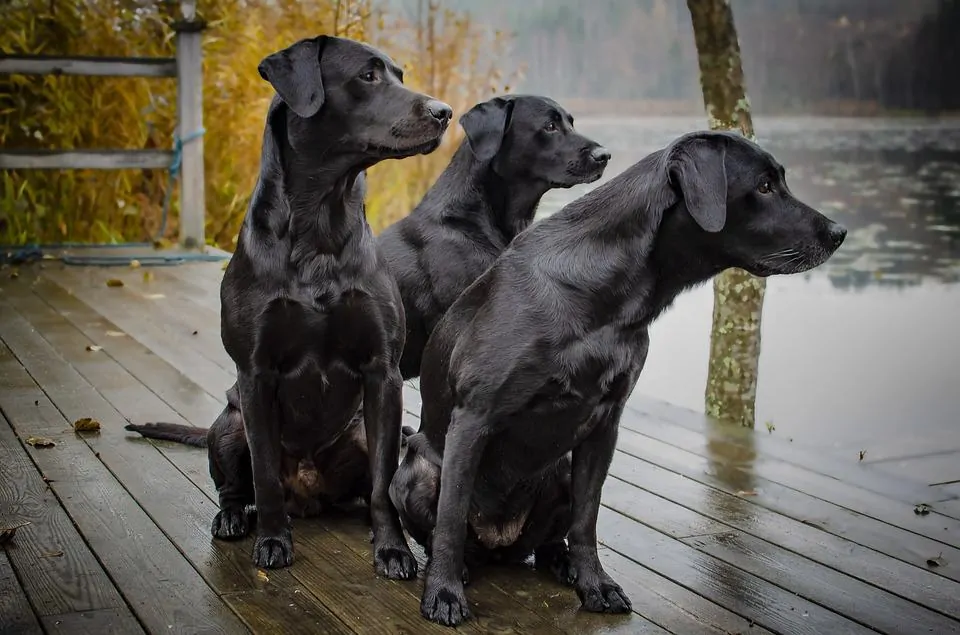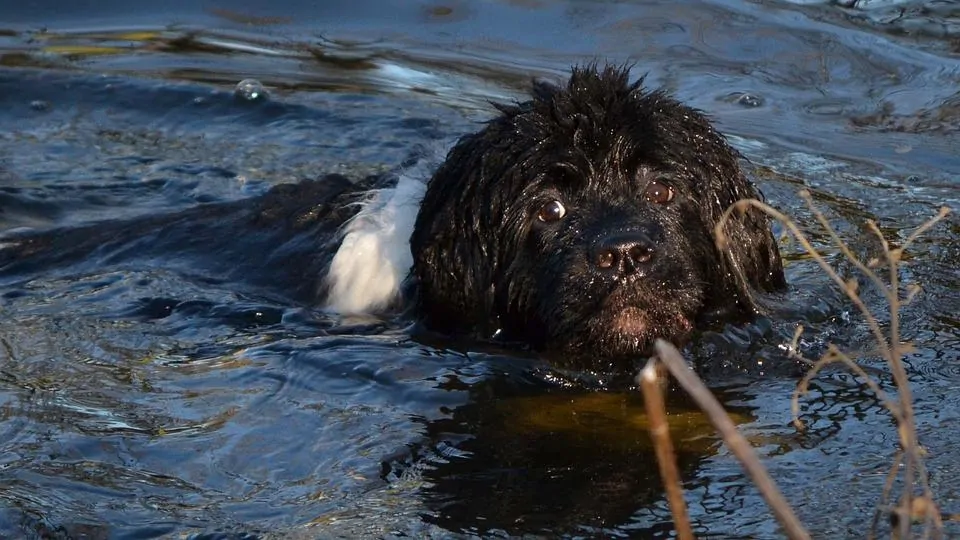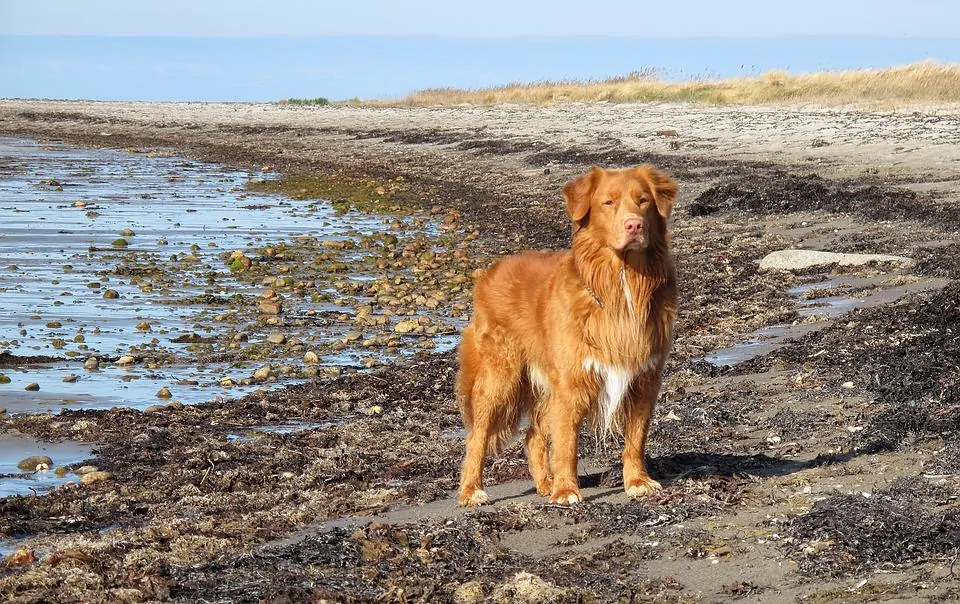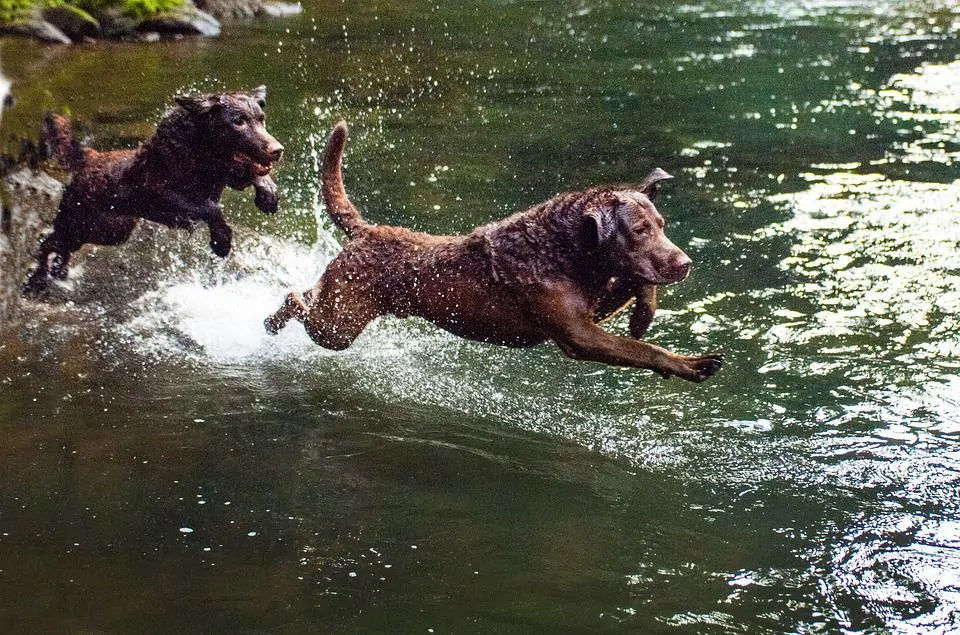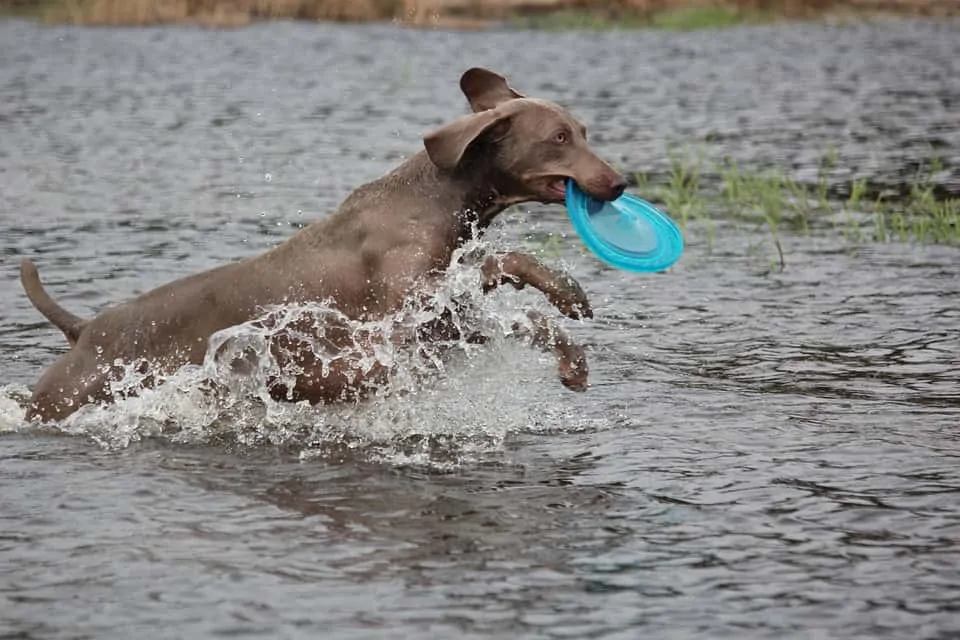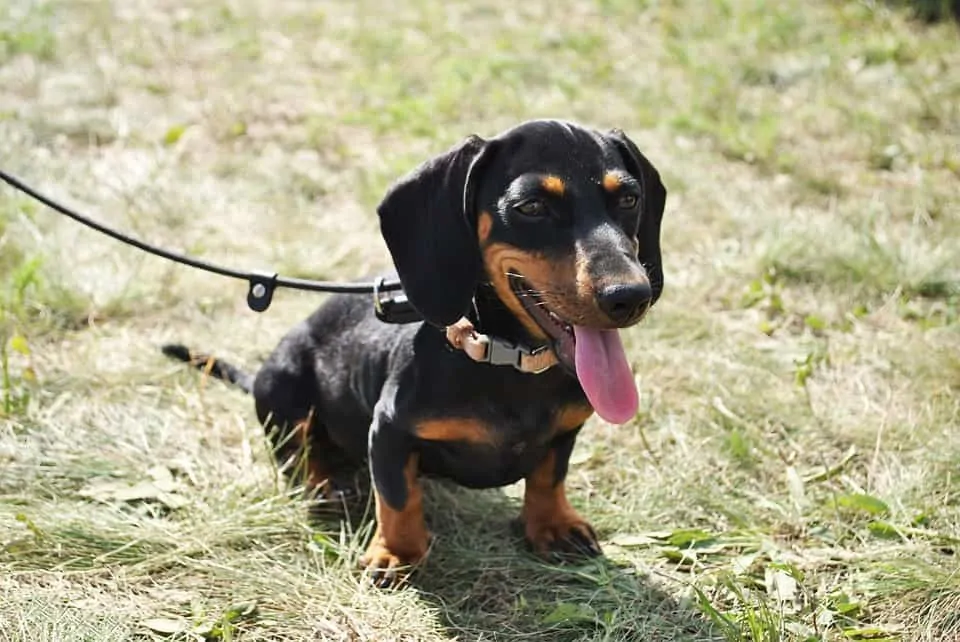Have you ever looked at a doggy’s paws? I mean really looked?
If you have a bit of a paw fetish and have examined enough doggy feet, more than likely, you have noticed that some breeds of dog have webbed feet and some don’t.
So why is it that some canines have extra skin between their toes? And are those that do really better swimmers?
In this article, we’ll take a look at these questions and introduce you to thirteen amazing breeds with duck feet that are sure to swim (or dig) their way into your heart.
Contents
Why Do Some Dogs Have Webbed Feet?
To understand why some dogs have webbed feet while others don’t, we first need to look at the genetic cause behind this unique characteristic and the development of puppies in utero.
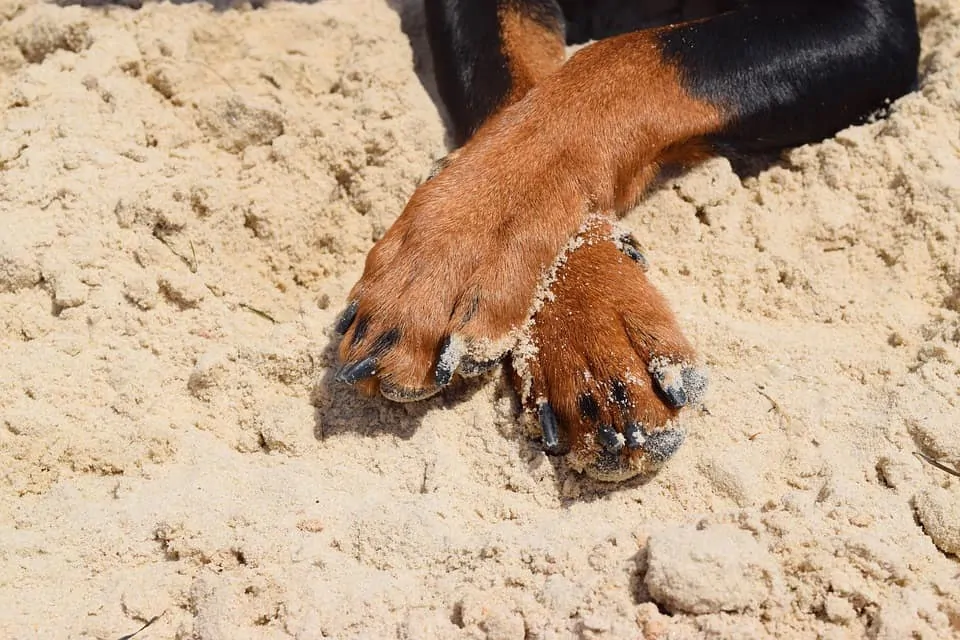
All dogs start out with webbed feet
Syndactyly, the scientific term for webbed fingers and toes, is actually common to all mammals. At least, in utero.
In fact, even human fetuses show webbed digits up until about the 7th week of gestation. At this point, the cells that make up the webbing on the hands and feet die off.
A similar process occurs in canines but to a lesser degree.
Unlike humans who retain almost no webbing when normal development occurs, almost all canine species carry some degree of webbing on their paws. Wolves, which all domestic dogs are descended from, have a high degree of webbing.
When looking at the domestic dog, some breeds retain more webbing than their wolf ancestors while some retain less. To understand why these differences exist, we need to look at how webbed feet can be useful.
Webbed feet make for stronger swimmers
As you have probably already guessed, webbing in the paws makes for powerful swimmers.
This is because having a flap of skin connecting each toe allows more surface contact with the water. A webbed-foot dog has more power when they push against the water as they paddle.
Consider the way a diving fin helps extend and flatten the surface area of the human foot to aid in swimming. The webbed dog paw achieves this same goal.
When early fishermen and hunters were breeding dogs to help them on ships and near lakes, they actively selected dogs that were stronger, faster swimmers. While they may not have realized it at the time, what they were truly breeding for were dogs with an abnormally high degree of webbing on their paws.
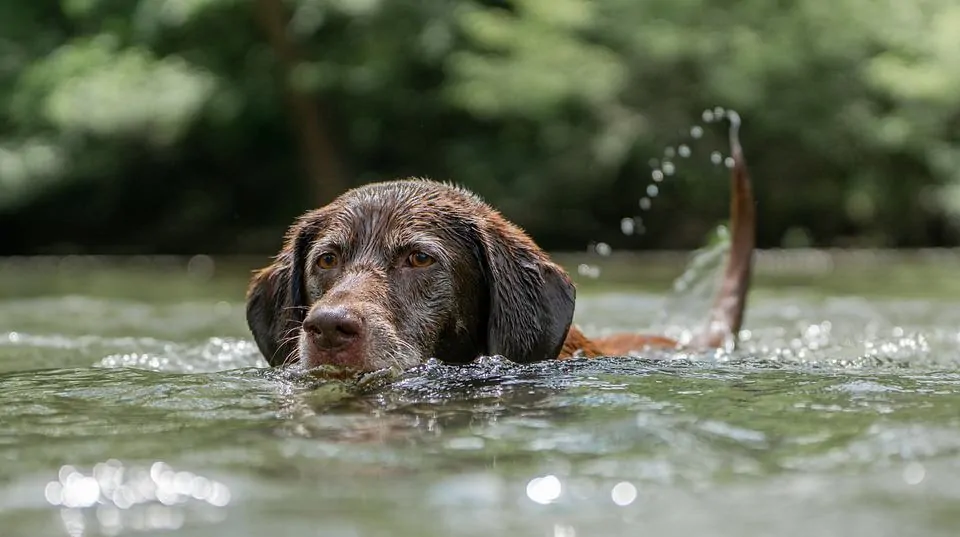
Webbed feet can help with other tasks, too!
Webbed feet aren’t just helpful in the water.
That same increased surface area also makes some dogs better diggers than others.
Using a pitchfork to dig a hole would be a long and arduous process. Using a shovel would be much faster.
The typical dog paw with limited webbing is more akin to a pitchfork. The dirt slides between the toes with each movement. But webbed feet work more like a shovel, allowing more dirt to be moved with each swipe.
>>>Check out these 21 breeds with adorably curly tails.
For this reason, some vermin hunting breeds have webbed feet. Like great swimming dogs, this trait likely appeared because breeders were selecting for strong diggers, not because they were actively breeding only webbed footed dogs together.
Webbing between the toes also helps dogs walk in deep snow, which may be one reason wolves retain this odd trait.
13 Dog Breeds with Webbed Feet
Now that you know how webbed feet came about and why they are useful, let’s take a look at some of the more popular webbed-footed dog breeds.
Labrador Retriever
Thanks to their duck-feet and rutter tails, Labs are some of the fastest dogs in water. This is true whether they are chasing a ball, a downed goose, or a fishing net.
By far the most popular of the duck-footed breeds, the Labrador Retriever was first bred in Newfoundland to aid fishermen in gathering nets and chasing down escaping fish.
They needed to be strong, agile swimmers in order to accomplish tasks quickly in the frigid northern waters. Fowl hunters later took advantage of this trait and repurposed the breed to retrieve downed game from lakes and ponds.
The Lab is a gentle, fun-loving companion that makes for a great family pet. They need a lot of exercise, especially when young, but are intelligent, loyal, and easy to train.
Portuguese Water Dog
The Portuguese Water Dog was bred as the ultimate fishermen’s companion. They would assist the sailors by retrieving fishing nets and tackle, swimming messages between ships, and even herding fish into nets.
The PWD likely descends from the original Poodle-type breeds of Europe. They retain a similarly curly coat, love of water, and, of course, webbed feet.
Today’s water dogs are kept largely as loving companions. They are independent, intelligent, and make great competitors in dog sports like agility.
Newfoundland
Even Newfie puppies have a love for the water. Because of this love and their large size, many of these big teddy-bear dogs are used today by the coastguard to assist in emergency water rescues.
Like the Labrador, the Newfoundland was originally bred in Canada to help fishermen bring in nets and retrieve gear that fell overboard. Their large size and powerful swimming abilities also made them useful for rescuing fishermen that fell into the water.
Many Newfies are still used in search and rescue today. Their thick coats and deeply webbed paws make them the perfect canine to toss into the frigid arctic waters to save drowning sailors.
At home, the Newfie makes for a gentle companion that is great with children and tolerant of even the most boisterous behavior. They tend to be calm dogs that enjoy walks and hiking almost as much as they love cuddling up with their owners on the couch.
German Shorthaired Pointer
The German Shorthaired Pointer was bred to be the ultimate gun dog. They are capable of tracking, pointing, and retrieving.
The webbing between their toes is useful in the water but even more important to help them move effortlessly across saturated soil around ponds and lakes. This trait was useful when fetching downed fowl, but even more important in the pursuit of deer and other large game.
As a pet, the GSP is a high-energy pup that requires a job to do. They make great jogging and hiking partners and are excellent sport dogs. They are loyal and intelligent and do great with children and are affectionate toward everyone they meet.
Nova Scotia Duck Tolling Retriever
By tossing a ball to their duck toller from the blind, hunters were able to entice their dogs into moving along the shoreline like a fox, a tactic that attracts the attention of ducks. Once the ducks were close, the hunter would recall their dog and rise from the blind, sending the birds into the air where they could be shot down and then retrieved.
The Nova Scotia Duck Tolling Retriever is a lesser-known Canadian water dog. It was originally bred as a gundog to assist hunters in retrieving downed fowl from bodies of water. But its job during the hunt is far more complex than that.
The Duck Toller was bred to resemble a fox and used by hunters not only to fetch fowl but to entice the birds closer to shore so they could be easily targeted. By running back and forth along the water’s edge, the dog would catch the duck’s curiosity the same way a fox might.
This process is known as “tolling.”
While many Tollers are still used by hunters today, just as many enjoy a simpler life as a trustworthy and energetic companion. These dogs make great family pets and pack a lot of energy into a small package.
German Wirehaired Pointer
The German Wirehaired Pointer was created through intentional crosses using the Shorthaired Pointer as a base. The breeders wanted an all-around hunting dog with a thicker coat that could work in colder climates and environments with dense vegetation.
By crossing the GSP with Griffons and other wirehaired pointers, the breeders were successful in creating a dog with the versatile working talents of a GSP but with a thicker yet still easy-to-maintain coat.
GWPs are less common than their short-coated cousins but still make popular pets for families and hunters alike.
Chesapeake Bay Retriever
Built like a Lab but with a uniquely curly and water-resistant coat, the Chessie shares a similar love for water and fetching as their Labrador cousins.
Like other webbed-feet retrievers, the Chesapeake Bay Retriever was developed primarily as a fishermen’s companion and later repurposed as a gundog. They were first bred in the Chesapeake Bay region of the US and were celebrated for their courage, work ethic, and overall happy disposition.
While less popular than the Lab, the Chessy makes for a similarly dependable companion. They are generally loving and loyal dogs that do well with people of all kinds so long as they are well-socialized as puppies.
American Water Spaniel
This lesser-known spaniel is the state dog of Wisconsin, the state where it was first created. They were bred originally to hunt game on both land and in the water. The American Water Spaniel’s thick curly coat protected them during the frigid Wisconsin winters while their smaller stature made them easy to transport and care for.
Endowed with an even temperament, the AWS is less energetic than the typical waterfowl dog and is a great choice for both rural and urban living. This is true so long as they are given enough attention, moderate exercise, and early training. They do tend to bond more strongly with one owner.
Poodle
Those who don’t know the poodle breed are often surprised to learn how much these dogs enjoy the water. Their tightly curled coat, webbed feet, and agile bodies were all bred for the purpose of moving in and out of the water easily.
While not often thought of as a water dog or a retriever, the Poodle is actually a veteran in both categories.
This curly-coated breed was used in Europe for centuries to perform a variety of tasks. They were often kept by nobility and were prized for their intelligence and ability to learn any job given to them. Like many retrievers, they were most often used for fetching downed waterfowl and fishing nets.
While the progenitors of the breed were used for many jobs, the modern Poodle is kept almost exclusively as a companion animal. Their intelligence and willingness to please make them great dogs for families and individuals.
Otterhound
As the name suggests, the Otterhound was first bred to hunt otter in England in the 1800s. To take on such an intelligent and feisty foe, these dogs needed to be brave, smart, and capable of moving quickly through the water.
Once otter numbers fell in the region, the tradition of otter hunting fell out of style. Many Otterhounds were repurposed for hunting mink, but, overall, breed numbers fell dramatically.
Because the Otterhound was bred for such a specific purpose, their use as companion animals was limited. Today, only a few hundred of these dogs are kept as pets.
Weimaraner
Many hounds are accustomed to moving through bodies of water in pursuit of game, but the Weim is unique among the hound group for its true love for swimming.
Used almost exclusively as gundogs by royalty in what is now Germany, the Weimaraner was prized for its use in hunting large game such as bear, boar, and deer. As the years went on, the breed was refined and used more frequently on smaller game like fowl and foxes.
While they have a body shape more similar to a pointer, it is thought that the Weim actually descended from early scenthounds, like those that eventually gave way to the Bloodhound.
Today’s Weim’s are prized for their fun-loving and energetic personalities. They have strong hunting instincts and don’t make great siblings for smaller pets. Training is a must for these headstrong hounds as is early socialization.
Irish Water Spaniel
The Irish Water Spaniel has been used for centuries as waterfowl hunting dogs. Like other spaniels, they were responsible for finding, flushing, and retrieving birds, a job that required them to swim through the frigid Irish pounds and lakes.
Their thick, curly coats and webbed feet made an otherwise difficult task more than possible. Their proficiency as hunting dogs is one reason the breed has been used to create other spaniel lines including the American Water Spaniel.
As pets, the IWS is gentle and affectionate with children. They are rarely aggressive but are known for their intimidating bark and can make great watchdogs. Like the American Water Spaniel, they are less hyperactive than many hunting breeds and enjoy lounging around on the couch almost as much as running through the fields.
Dachshund
Everything about the Doxie from its long body to wide, webbed feet was purpose built. Even their pointed noses and oversized, lop ears helped them track and catch vermin on the farm.
Not at all known for their swimming abilities, the Dachshund utilizes their webbed feet for an altogether different task.
These long-dogs were bred to hunt vermin, a job that often had them venturing underground to follow their prey. Having webbing between their toes and short legs, allowed the Doxie to dig faster than other hounds and terriers.
While their modern lifestyles rarely have them chasing rats into burrows, today’s doxies still enjoy showing off their digging skills in the backyard. These little wienies make good family pets, so long as you provide them enough stimulation to keep those digging instincts in check.
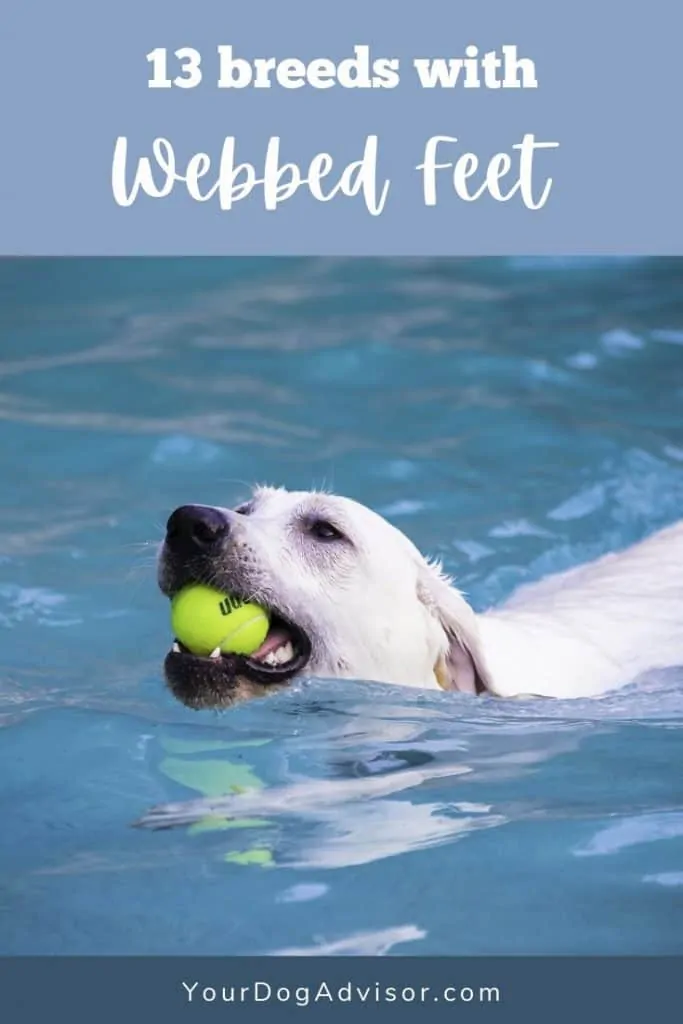

Sara Seitz has spent most of her life in the pet industry and has a bachelors in animal behavior from Colorado State University. Sara started working with dogs and cats as a high schooler at a rural boarding kennel. There she learned a lot about the bad and the ugly of the pet service industry. But not even the toughest day at that job would dissuade Sara from following her dream of working with animals.
In college, Sara got a job at a dog daycare and boarding facility in Fort Collins, Colorado. Her new career provided even more opportunities for learning about dog behavior than her classes did. As general manager of the daycare, Sara helped the company launch a new in-home pet sitting branch and trained to become a certified dog trainer. Between shifts taking care of peoples pets in-home and supervising dogs during playtime at the daycare, Sara organized and taught obedience classes.
Sara has always been passionate about bettering the lives of our canine companions. She soon found that advocating for and educating owners in the power of positive reinforcement training was one of the best ways to help dogs and their owners live happier lives.
